Who Shaves The Barber?
Monday, March 08, 2010
 Rebecca knows the meaning of the expression, “Who shaves the barber?” Every once in a while she will insist on taking my picture even when I am hovering around with my heavy medium format Mamiya RB-67 and my equally heavy tripod. These snaps were taken in June 2009 at the Nitobe Japanese Garden of the University of British Columbia. The girls and Rosemary love the place so we go often.  Rebecca was keen on photography a few years ago so we went to Leo's to buy her a digital camera. When it stopped working I bought her a new one. But there seems to be no follow up at home so she has lost interest even though she is so good in front of my garden. It is methodical Lauren who always wants to look through the viewfinder of my Mamiya and I am wondering if she just might inherit my vocation. It would be most pleasant to will all my useless film cameras (presently so useful to me) to my Lauren. 
Just A Handful Of Magnesium Sulphate
Sunday, March 07, 2010
 I don’t particularly like VanDusen manure Saturdays. It happens once a year and it happened yesterday. I drove over to pick up 12 bags of well rotted manure (it hardly smells) and brought it home. It was a nice enough day that I went at distributing it among my roses immediately using my large orange/red wheelbarrow. I mix the manure with last year’s fall VanDusen compost (another day I don’t particularly like). To this mixture I add handfuls of Epsom salt (magnesium sulphate) and generous amounts of alfalfa meal. The magnesium salts in early spring help the rose bushes absorb the nutrients that may be present in the soil. The alfalfa meal (which I buy at the Otter Co-Op in Langley) is supposed to induce roses to send up basal shoots (Nice thick and vigorous ones that grow to be healthy canes. These come up from the base root of the plant). When Rebecca showed up at noon I told her that today Sunday we would to the same with her roses and that we would also prune them. And we would also transfer root-bound roses to bigger pots. I was going to bring a back of compost and a bag of manure plus my Epsom salt/alfalfa meal mixture. I showed up at two and it was drizzling. Rebecca was dressed to the teeth and had a nice scarf draped around her neck and shoulders. “Do we really have to do this today?” she asked as she looked in the direction of a friend. It was obvious that I had interrupted a pleasant and lazy Sunday afternoon in which anybody with an attorney would be recommended to do nothing. I stuck to my guns, “We knew about it since yesterday. Let’s do it.” She accompanied me outside with her beautiful silver flats. I pointed out that she would have to change as she would be on her knees potting and mixing manure with compost. She relented and when she returned she was all enthusiasm. We worked at her roses which all look very healthy in their pots even though most roses do not like to be in pots. Rebecca’s back yard is a concrete driveway so the pots are her only choice if she is going to have a garden. Her friend said, “You have a lovely garden.” Rebecca agreed even though her friend added, “Balfour owns this property and they don’t want to spend any money in landscaping; besides the home owners here want the space for their cars.” While Rebecca’s garden is not big it makes up for it with an unusual collection of old roses and rare hostas. In May/June her backyard is a feast for the eyes and delight to the nose. Her sister Lauren began her gardening a couple of years ago with my gift of some blue/yellow winter pansies. They are indestructible and they keep blooming every year. She also has a miniature hosta called ‘Peanut’. Rebecca’s father predicted that Rebecca’s roses would all die this year, “She doesn’t take care of them.” I sort of beg to differ but I told Rebecca that this would be her challenge for the year by proving him wrong. One of my loveliest rose in my garden is a Gallica of unknown origin called Charles de Mills. It blooms only once as Gallicas are old roses and this is their pattern. The blooms are complex with a myriad of petals. The flower itself seems as if someone went at the front of it with a sharp razor. The scent is heavenly and the flowers are a blue/crimson that defies description. There is another attribute of this plant that is not generally known. It is one of the few roses that send underground runners (some go under wood fences) that grow to be little clones of the parent. After two years I severe the relationship with a sharp knife and re-pot the plant. This year Rebecca and my friend Paul Leisz are getting one. Paul’s is from last year while Rebecca’s is from two years ago. Last year her Charles de Mills (still in my garden) had at least 40 flowers! I have placed many a picture of Rebecca with a rose in this blog. This particular one, taken last May/June, shows Rebecca, 11, more as a teenager looking to her adulthood. Her hair is adorned by a splendid example of Rosa ‘Charles de Mills’. While Rebecca and I happily worked on her roses, her friend (in the drizzle) was busy texting with her thumbs. When I pointed this out to Rebecca’s father he said, “She is in high school. They all do that.” Will Rebecca be like the rest? Will her love for roses and gardening continue? Will her roses die? Only time will tell. Meanwhile I just wish that treating would-be teenagers were as simple as throwing in a handful of magnesium sulphate and alfalfa meal on our beloved roses.
The Carrot & The Stick
Saturday, March 06, 2010
 For close to 12 years we have been getting Rebecca (and then also her sister Lauren when she was born 8 years ago) on Saturdays. Both of her parents work so we do babysitting support. Rebecca routinely babysits, on her own, for some neighbours so the writing is on the wall for us. Soon Rebecca might be trusted to take care of her sister at home or perhaps she will simply become an independent teenager, who will stay at home while we take care of Lauren. For most of these years the Saturdays have been pleasant and heartwarming days when we have attempted to challenge the girls (the stick) with music, gardening, museum-going, ballet and modern dance evenings or concert evenings. The last one was a Gershwin concert at the VSO a few weeks back. I have picked films that I thought Rebecca should be exposed to such as Tarzan The Ape Man, Gunga Din and The Red Shoes. But “too much” culture can make little girls’ interest diminish so we have applied the carrot with plenty of food goodies they like like “double-stuff” Oreos and an unlimited access to the fridge. It has been Rosemary who has warned me about being too strict with Rebecca as she will not want to come to our house when she does not see the fun of it. For a while I enjoyed whacking (gently) them on the head with the TV remote. When Lauren described this to her other grandmother I received a phone call from my daughter to cease the abuse, or else. It is generally understood that grandparents play (when living in the same city) a necessary role in the education of their grandchildren. If the grandparents have funds in the bank, the help can be a financial one. If the parents work and cannot afford a babysitter, grandparents become surrogate babysitters. The above can be seen in strictly objective terms. Grandparents do as they are told and perform as is expected of them. But there is a subjective side to this. Grandchildren can grow on the grandparents. When they leave on Saturday nights we are left with a feeling of emptiness. The fine line between the carrot and the stick then becomes important when the implied (even if never uttered out loud) threat of ending the Saturdays and the Mondays (I pick up the girls at school on Mondays) is understood. And with Rebecca at 12 it is only a matter of short time when going on a date with a girl or boy friend will trump a Saturday visit to the boring grandparents. This is inevitable and I can see the day coming. I keep telling Rosemary that we need to think of alternatives or our life will feel vacant. 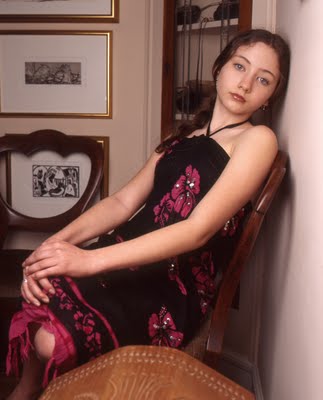 Yesterday, Saturday was a preview of things to come. Rebecca brought her well-mannered friend Jessica. We took the three girls (including Lauren) to Watermania in Richmond. Jessica and Rebecca played and chatted in the water. They cast their disapproving eyes on a young boy who was extremely overweight. At one point I asked Rebecca if she wanted to swim some lengths with me so she could practice her beautiful backstroke. Her, “No,” was predictable. At age 67 one side of me objected at the idea of having to share my precocious granddaughter with her friend. But I also understood that this was the way it had to be and perhaps some day in the not so near future I might again have a relationship with my granddaughter that will be mature as we explore cultural events together. I watched Lauren in the wave pool. She is now not in the least afraid of the water. She has developed a self-confidence reflected by a wide smile as she navigated the deep end in a foam float. She would fall off every once in a while but there was no panic in her face. It was comforting to see her as it was to see Rosemary hovering around and keeping a watch. Last night I caught Rebecca using her hands to pick up the shredded Parmesan to put on her gnocchi. “There is a spoon for that! I am shocked at your manners,” I told her, in the presence of her friend. Rebecca's wise mother turned to tell me, “There are times when you should not pursue a battle. This is one such time.”
Man Eats Dog
Friday, March 05, 2010
Over There
Faith Healing and the Original Hot Dog
By Mati Laansoo
Illustration by Marv Newland
Vancouver Magazine, March 1982
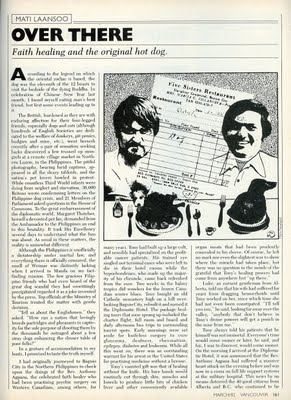
According to the legend on which the original zodiac is based, the dog was the eleventh of the 12 beasts to visit the bedside of the dying Buddha. In celebration of Chinese New Year last month, I found myself eating man’s best friend; but first some events leading up to it.
The British burdened as they are with enduring affection for their four-legged friends, especial dogs and cats (although hundreds of English Societies are dedicated to the welfare of donkeys, pit ponies, budgies and mice, etc.), went berserk recently after a pair of sensation seeking hacks discovered a few trussed up mongrels at a remote village market in Northern Luzon, in the Philippines. The pitiful photographs, bearing lurid captions, appeared in the sleazy tabloids, and the nation’s pet lovers howled in protest. While countless Third World infants were dying from neglect and starvation, 30,000 Britons wrote condemning letters on the Philippine dog crisis, and 21 Members of Parliament asked questions in the House of Commons. To the great embarrassment of the diplomatic world, Margaret Thatcher, herself a devoted pet fan, demanded from the Ambassador to the Philippines and end to this brutality. It took His Excellency several days to understand what the fuss was about. As usual in these matters, the reality is somewhat different.
Although the Philippines is unofficially a dictatorship under martial law, and everything there is officially censored, the smell of Weimar was distinctly lacking when I arrived in Manila on my fact-finding mission. The few gracious Filipino friends who had even heard of the great dog scandal they had unwittingly precipitated regarded it as a joke invented by the press. Top officials of the Ministry of Tourism treated the matter with gentle derision.
“Tell us about the Englishmen,” they asked. “How can a nation that lovingly breeds partridges and pheasants in captivity for the sole purpose of shooting them by the thousands be outraged about a few stray dogs enhancing the dinner table of poor folks? ”
In a gesture of accommodations to my hosts, I promised to taste the truth myself.
I had originally journeyed to Baguio City in the Northern Philippines to check upon the doings of the Reverend Anthony Agpaoa, the celebrated faith healer who had been practicing psychic surgery on Western Canadians, among others, for many years. Tony had built up a large cult, and sensibly specialized on the profitable cancer patients. His trained eye singled out terminal cases who were left to die in their hotel rooms while the hypochondriacs, who made up the majority of his clientele, came back refreshed from the cure. Two weeks in the balmy tropics did wonders for the frozen Canadian winter blues. Tony bought and old Catholic monastery high on a hill overlooking Baguio City, rebuilt it and named it the Diplomatic Hotel. The package healing tours that soon sprang up included the charter flight, full room and board and daily afternoon trips to surrounding tourist spots. Early mornings were set aside for knifeless surgery to cure glaucoma, deafness, rheumatism, epilepsy, diabetes and leukemia. While all this went on, there was an outstanding warrant for his arrest in the United States for practicing medicine without a license.
Tony’s vaunted gift was that of healing without the knife. His bare hands would routinely cut through skin, muscles and bowels to produce little bits of chicken liver and other conveniently available organ meats that had been prudently concealed in his sleeve. Of course, he left no mark nor even the slightest scar to show where the miracle had taken place, but there was no question in the minds of the grateful that Tony’s healing powers had come from anywhere but “up there.”
Tony always told his patients that he himself was not immortal. Everyone’s time would come sooner or later, he said and his, I was to discover, would come sooner. On the morning that I arrived at the Diplomatic Hotel, it was announced that the Rev. Anthony Agpaoa had suffered a massive heart attack on the evening before and was now in a coma on full life support systems at the military hospital. This news by no means deterred the 40 good citizens from Alberta and B.C. who continued to be operated on by four assistant healers, suspicious looking youngsters in T-shirts and Adidas runners who bore an uncanny resemblance to Manila cab drivers.
But back to the main story: man eats dog. The morning’s doings at the Diplomatic having left me somewhat puckish, my guide drove me to the Five Sisters Restaurant of the Slaughterhouse Compound. There I met the jovial proprietress Mrs. Marcia C. Villaneuve, a locally celebrated cook. The restaurant was empty except for a lone Jeepney driver eating his daily dog, and a quiet foursome dining on a mixed menu that included the house specialty. I learned from Mrs. Villaneuve that in the remote barrios of the Philippines, where the average income is less than $5 a week, homeless mongrels are sometimes sold for food instead of being gassed to death by the SPCA. She went on to point out that “fragrant meat,” as the Chinese call it, is considered a delicacy only when the diners know that it is dog they are eating.
I ordered a round of San Miguel beer for the Five Sister’s lunchtime patrons and a plate of canine casserole for me and my guide. The dish arrived promptly, a rather nondescript gray in appearance, its gravy dotted with a few bay leaves. The taste was very much like some of the better Chinese meat dishes done in garlic and black bean sauce: a bit chewy, somewhat spicy and vaguely redolent of pigs’ trotters with all the little leg bones and knuckle joints to crush on. Appearances notwithstanding, it was very tasty, and arguably good value at 10 Pesos, or $1.35.
Of course, I complimented Mrs. Villaneuve on the delicacy of her dish, and she in turn beamed her approval and suggested that I pass on the recipe for culinary adventurers overseas. The carcass she said, should be skinned and hanged by a competent butcher, after which the choice meat should be cut into bite-sized pieces and cooked in rice vinegar for a very long time until it becomes “al dente.” After that, the meat is salted and simmered in a broth of oil, garlic, bay leaf and pepper, with a dash of monosodium glutamate to bring out the bouquet. It is then served piping hot in its own rich gravy, with a side order of fried noodle and sliced green mangoes. All cultural impediments aside, the dish (as many early European navigators in the region have testified) is delicious, although like the barnyard chicken who has become familiar enough to have earned a name, likely less so if you happen to have known the dish wagging its tail earlier.
I confess that after my Philippine luncheon I now look at my canine friends with renewed respect, and rather suspect that the feeling is mutual. These days, whenever I meet dogs fooling around in the street or being tedious at the pub, I just point my finger at them, like Charles Bronson in Death Wish, and they smarten up real quick, because they know.
An Apology For My Rosy Past
 Some of you might suspect that I am running out of ideas and inspiration to write my daily blog and that I am getting ready to shelve the now four-year-plus project. This would be far from the truth as I have no problem in drumming up stuff to put up here. If anything one of my problems is to stop my desire for multiple blogs in one day. This is a rare example of one. So why is it that I am resorting to pulling a Lazarus on articles written many years ago by writers that I admired who worked for the magazine, Vancouver Magazine, run by Mac (a.k.a Malcolm ) Parry? You might suspect that to anybody my age (67) the past will always be rosier and better. In fact I would not agree with you. So much stuff nowadays is so much better. When we arrived to Vancouver in 1975 the city’s bread was a distinct but nondescript variety of cardboard. I longed for the bolillos of Mexico and the handmade corn tortillas. But it has all changed. Even Safeway now bakes a credible croissant and a three-cheese focaccia. My wife’s Sony clock radio (with a CD player) sounds better than some of my early stereo systems of of rosy yesteryear. The plastic housing of modern lenses might not have the heft or the feel of my old Takumars and Nikkors but their computer designed optics surpasses my old clunkers in performance. And to end all arguments about that rose and better past what would be your old-fashioned equivalent to modern Viagra? Nevertheless I don’t completely accept that the present is better than the past. My granddaughter Rebecca refuses to use my mother’s cook books. She will not consult Mary Lou Glass’s Recipe for Two (1947), Rombauer/ Becker, The Joy of Cooking (1953 Edition) or Marion Brown’s The Southern Cook Book (1968). But although she says that the recipes she finds on the internet are better because they are more modern she will have several helpings of Adalyn Lindley’s Chicken a la Barbara from the latter Southern Cook Book when I prepare it for some of our Saturday dinners. What these stories and essays from the past do prove is that during Mac Parry’s stewardship of Vancouver Magazine from April 1974 to December 1988 we had a lively, intimate, warm, interesting, challenging city magazine that was visually arresting with many illustrators and photographers who contributed. The magazine had a policy of monthly “piss-ups” where contributors would feast on terrible chips and cheap raw-tasting Portuguese Vinho Verde or beer. Writers, illustrators and photographers would compare notes and ideas would spring from these for future issues of the magazine. It was Mati Laansoo (who is not ashamed to admit to have eaten dog), an Estonian writer with Texan tendencies to collect small arms and store them under his pillow who recently told me, “Mac was like William Shawn. He liked to surround himself with a variety of good writers, and illustrators and he encouraged them to give their all.” It was Mac Parry who first instigated me to write my first piece on my experiences as a sailor in the Argentine Navy. I remember a young man who came in one day with slides of people wearing Hawaii T-shirts. He ran a piece on that subject a few months later. One of the pictures featured a Santa Claus attached to two scantily clad (tiny T-shirts) in Hawaii which elicited hate mail a few hours after the magazine hit the stands. This was indeed the case when Laansoo’s Over There hit the March 1982 stands. There were letters and furious phone calls from pet lovers. I remember that March 1982 very well. A month before Mac had taken me to the Cecil Hotel for a beer and told me, “Sean Rossiter has written a piece about his cat. It has cancer. I want you to go home and photograph your cat and make sure its whiskers are sharp. But I did not only have the cover. I also had some interesting pictures for a piece written by Les Wiseman. 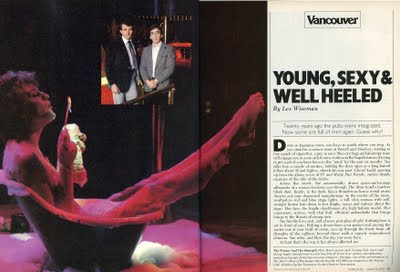 At the time writer Les Wiseman and were avid followers of the descendants of Salome and we came up with a ploy to convince Mac that it was worth a feature. We convinced him on the business side of exotic dancing. I think that in 1982 Mac had skillfully managed to keep his independence as an editor from the hands of our publisher Ronald Stern. It seemed like Mac could run articles about nonsense (such as the piece by Ben Metcalfe in this blog a few days past) or wild dogs in Iran and Stern would not protest about these stories not having the substance to attract advertisers to the magazine’s pages. In fact Mac came up with the idea for running two different covers that March. One was to feature the cat and the other a stripper. It would have been an experiment that would have preceded Chicago Magazine’s run a few years later featuring the city’s mayor smiling in one batch and serious in another. Stern quashed the plan and I never had to test the waters of demanding a double cover pay! The illustration to Laansoo’s piece is by our very own famous illustrator and animator Marv Newland. I suspect that he used a cheap copier type technology to come up with the concept. He did confirm with me (yesterday) that Laansoo did indeed provide him with the restaurant’s bill of sale as proof. In the illustration, the man on the left is Mati Laansoo. The man on the right (described as “my guide”) by Laansoo is Gary Marchant. Marchant wrote what is considered to be one of the best travel columns ever, anywhere, called Faraway Places for Vancouver Magazine. I remember with great fun the day that Marchant told me a story of traveling through some remote African country (it could have been Chad). He arrived at a small town exhausted and hungry. He inspected the large pot simmering over a fire at his little hotel. He spotted some bones in the stew. The cook gestured with his arms to represent a bird so Marchant assumed the stew was chicken or some similar fowl. He helped himself to a large portion. He was licking his chops when he spotted a little horrific skull staring at him. It was the little head of a bat. Perhaps my past, or at least my past as a magazine photographer was a rosier one. Perhaps the present with the universal and all-encompassing presence of the net has made those magazines of my era irrelevant. My friend Mark Budgen says I am sentimentalizing it. My friend John Lekich says that those magazines had heart and the present ones don’t. You who read this can be impartial judges. As for me I remember my grandmother’s words, “Nadie te quita lo bailado.” Nobody can take away from you the pleasures you had. And many pleasures I had reading the stories of Lansoo, Wiseman, Lekich, Marchant, Hunter (Bob), Metcalfe and many others who all wrote from the heart.
El Santo De La Trompeta
Thursday, March 04, 2010
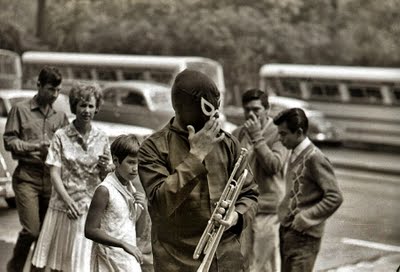
Throwing Dishes & Blueberry Cream Pies
Wednesday, March 03, 2010
I divide the people that populate our world in two. There are people who throw dishes in anger and those who don’t. I am from the first category. 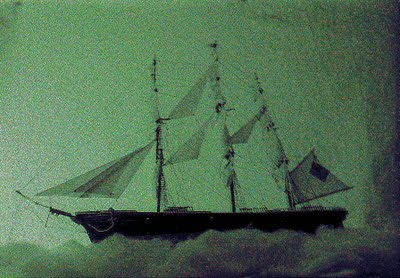 On Sunday Rebecca stamped her feet and started yelling how she hated making pie crust. She showed it to me and told me, “It’s too hard. Something did not happen right.” And she promptly threw it into the kitchen trash can and stormed off. At age 12 we are all saying that Rebecca is at that point in her life where she is about to become a woman in body while the mind is not quite there yet. I am not all that sure of this. In 1957 I took this picture of my Revell replica plastic kit model S.S. Constitution (Old Ironsides) with an Agfa Silette. I placed my finished ship on a bed of cotton. The picture is not all that sharp. I have played around with Photoshop here to make it look like a fake late 19th century photo. My S.S. Constitution survived with many other models I built (cars, airplanes, ships and tanks) so that when I became a late teenager I gave them all away to my cousins, the Forments. There were several models that did not survive. One I remember well was H.M.S. Bounty. I was carefully applying the rigging (black thread) with tweezers when something just did not occur to my liking. I screamed. I got up. I threw the ship to the floor and then I jumped on it. My mother was all upset and almost in tears. I never quite outgrew these fits of destructive temper although I must confess here that when I am about to throw something I always weigh its value as opposed to its immediate need in my life. It might take a short second but I always think it first. I had been considered a gifted painter and drawer since I was 5 and by the time I was 10 I had been given many lessons. It was about then that I would become frustrated with an attempt to paint this or that that I would pick up my work in progress and tear it up as loudly as I could. At age 14 I suddenly and finally stopped painting. I received my last paliza (whipping) from my mother as punishment for my artistic block. My wife Rosemary, at first, like my mother did not know how to deal with my fits of temper. She would tell me to stop while screaming or crying. This always made it worse as I had an audience. In our early years of marriage most of the beautiful tea cups (some were Noritake or Wedgwood) went flying across the kitchen narrowly missing my distraught Rosemary. Here are two cups (the upper one is Wedgwood, and the lower Noritake) that survived my china onslaught. It took a while but Rosemary figured it out. She stopped being my audience and ignored my outbursts. These outbursts were almost always followed by intensely powerful migraines. My intelligent Rosemary gave me no comfort. It was sometime about 10 years ago when my weekly migraines suddenly ceased and I have not broken anything for years. 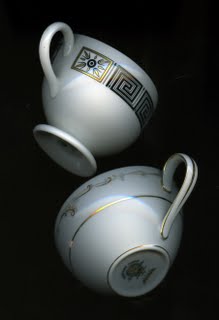 I observe in Rebecca something of myself. I am going to see if I can approach her with logic and explain how I was and how I regret the destruction of my H.M.S. Bounty. I have told her that anger and temper are never an excuse for rudeness. I think I will give her as a gift my two cups (I do have the saucers as Rosemary must have hidden them during one of my tantrums) and perhaps they will serve her as a guide to controlling her temper. Ever patient and low key Rosemary removed the pie crust from the trash can and rolled it out and lined a Pyrex pie plate. Rebecca was furious but she calmed down enough to say, “I will finish it.” This she did. She followed the recipe blindly and added the full count of sugar. The pie was too sweet. She was furious and refused to take a few slices home for her father. Just a few minutes before I started this I helped myself to the last slice of Rebecca’s blueberry cream pie. It may have been a tad sweet but thank God for women like my Rosemary.
Noble-Winged Seraphs Envied
Tuesday, March 02, 2010
Lolita, light of my life, fire of my loins. My sin, my soul. Lo-lee-ta: the tip of the tongue taking a trip of three steps down the palate to tap, at three on the teeth. Lo. Lee. Ta.
She was Lo, plain Lo, in the morning, standing four feet ten in one sock. She was Lola in slacks. She was Dolly at school. She was Dolores on the dotted line. But in my arms she was always Lolita.
Chapter 1, Lolita by Vladimir Nabokov

Some months back I took my two granddaughters to an Arts Club production of a musical called Nevermore: The Imaginary Life and Mysterious Death of Edgar Allan Poe. Even Lauren who is 8 managed to enjoy the musical play. She liked the costumes which resembled a modern Goth version of Alice in Wonderland. Rebecca had many questions on Edgar Allan Poe so I read The Telltale Heart to her after dinner. I did not do as a good a job as Iggy Pop and she found Poe a bit on the dull and repulsive side. She thought the Vincent Price version of The Fall of the House of Usher, renamed The House of Usher was cheesy. But at age 12 she knows more about Poe than the average 12-year-old and perhaps Poe might grow on her in the future.
My interest in Edgar Allan Poe began in 1957 when one of my English teacher Brothers of the Holy Cross at St Ed’s High School in Austin, Texas played a record in class. It was James Mason narrating Poe’s Annabel Lee. It was only a few weeks ago that I found the recording on one web page and as par for the course in this day and age of Google there is no information on date and record label. In fact my searches have taken me nowhere.
But I have a vivid memory of that recording but not vivid enough to remember that the recording had music in the background.
Thanks to James Mason I became a lifelong fan of all things Poe. I have read everything Poe wrote.
Of late I have read books in which Poe is a character such as in Matthew Pearl’s The Poe Shadow and Louis Bayard’s Pale Blue Eyes. The former is an extremely convoluted novel and the latter a bit more satisfying in which Poe, as a young cadet in West Point, assists a famous investigator after several brutal murders occur at the school.
I also liked Laura Lippman’s In A Strange City, 2001 (a novel in her series in which the main protagonist is a young female journalist-turned-investigator who lives in Baltimore, where Poe died and is buried). The novel centres around the well-known Baltimore ritual: Every year, on Edgar Allan Poe's birthday, a mysterious figure visits the writer's grave, leaving behind three roses and a bottle of cognac. When Tess gets wind of a plot to unmask the so-called Poe Toaster, she decides to stand guard. To her amazement, two visitors approach -- and one is shot and killed.
Some reader’s might know that for the first time ever the Poe Toaster did not show up this year on January 19.
I enjoyed a the 1951 film The Man With the Cloak (based on a short story, The Gentleman in Paris, by John Dickson Carr) with Joseph Cotten, Barbara Stanwyck, Leslie Caron and Louis Calhern. Cotton plays a failed poet called Dupin (!).At the end of the film, when Madeline (! The Fall of the House of Usher), played by Leslie Caron, goes looking for Dupin at a bar to thank him for a service rendered. Dupin's generous bartender Flaherty (Jim Backus) tells her he has gone, leaving only a seemingly worthless IOU for his sizable bar bill. On one side is a draft of a verse about a woman named Annabel Lee and the IOU's signature, which reveals Dupin's real name: Edgar Allan Poe.
While researching a bit of Poe to explain to Rebecca, I found out the hitherto (for me!) connection between Edgar Allan Poe and Vladimir Nabokov. It seems that the novel (published in Paris in 1955) was going to be originally called A Kingdom by the Sea. Humbert Humbert’s first love (unconsummated) is a young girl called Annabel Leigh.

This has led me to be currently reading The Annotated Lolita, Edited and with a preface by Alfred Appel, Jr. Two bookmarks are compulsory equipment here to keep track of all the footnotes, explanations, parody, coincidences (probably all intentional on the part of Nabokov) of this annotated version.
This Lolita came to me via former Vancouver Magazine associate editor (“Rock’roll died after the Beatles.”) and Nabokov scholar, Don Stanley. Three weeks ago the door bell rang at 8 in the evening. I opened the door to Don Stanley and wife. He said, “I have something for you,” and handed me the annotated version of Lolita.

One mystery remains for me. Since we know Nabokov published Lolita in 1955 (Olympia Press, Paris). When did James Mason record his reading of Poe’s Annabel Lee? Was the recording a possible reason Mason was chosen for the role of Humbert Humbert in Kubrick’s film Lolita in 1962? Or was it all Nabokovian coincidence?
The stand-in for Lolita here is Vancouver actress and mother of two, Corrie Clark. Clark recently conveyed to me the following:
These days I am working hard on screenwriting, among the days of motherhood. I am currently writing a screenplay about Emily Carr and again, ironically her
relationship as a 'surrogate mother' to a little girl who eventually lived with her for a few years when she was ...yes, 12.
|




















